|
Every animal species has a specific habitat consisting of one type or mixed vegetation that provides all necessary resources for survival of that species. Animals like Tiger and Elephants need large habitats for fulfilling their requirements and proper dwelling. But, the increasing unplanned developmental activities like construction of roads, railways, hydroelectric projects, cause disturbance in the natural ecosystem and lead to the breaking of large forest areas into small fragments which is referred to as Habitat fragmentation. Other activities like developing human settlements, clearing of forest land for agriculture and monoculture plantations also fragment forest areas into smaller sized patches. As a result of this, the wild animals do not find enough resources in the fragmented habitats and often come in contact with human settlements leading to conflicts between humans and animals. Some of main causes of human-animal conflicts can be stated as below:
- Increase in Human population: The increasing human population has also led to an increase in requirements of people. The settlements have also started expanding in urban and rural parts to meet the pace of growing populations. Many settlements have come up near the peripheries of protected areas, encroaching the forest areas and using it for their own benefit.
- Land use transformations – Humans encroach and clear large areas of protected forest patches for development of agricultural and horticultural lands. They also clear the areas, for monoculture plantations of Areca nut, Teak, etc. In Kodagu and Hassan districts people have transformed large patches of private forest lands into cardamom and coffee cultivations.
- Developmental activities - The construction of hydroelectric projects results in submergence of nearby forest lands and fragmentation of habitats. The clearance of lands for mining and industries also leads to breaking of large natural habitats into small patches.
- Habitat fragmentation and shrinkage - All the aforesaid reasons contribute to fragmentation of large habitats and shrinking sizes of forest patches. This makes that landscape unviable for wild animals as their needs are not fulfilled. As a result of which they wander in nearby areas searching for resources. This search leads them to human settlements where they cause damage leading to conflicts between humans and animals. In case of attack from wild animals like tiger and leopard, the village people also lose their precious cattle like cow, sheep, goat, etc.
Effects of Human - Animal conflicts
Larger sections of the people living in periphery of natural habitats of wild animals are of poorer sections mostly practicing agriculture and cattle rearing. They generally encroach the forest areas and use it for their own benefits like developing agricultural fields and monoculture plantations. In case of attacks of animals especially elephants, the farmers with small fields lose their entire life’s hard work in just moments and it becomes very difficult for them to come back in proper situation. The rich farmers also suffer great losses in elephant attacks and have to spend time and energy to cover the losses. Though, the government gives compensation for such incidents but that does not suffice as the number of claims is usually high and the resources with the government are not adequate to fulfill all of them. Also, the hard work that the farmers put in is also wasted.
The cattle loss is also an important effect of human - animal conflicts. The tigers and leopards are important animals of concern and common predators of the jungle. But when their habitat is fragmented, their movements are restricted and resources are limited. Hence, the cattle of nearby villages become an important target for them. So, they visit the villages at night and kill the cattle and disappear in jungle during day. Cattles are expensive to buy for the farmers and hence, their loss is of great significance to them.
One main part of human - animal conflict is also the revenge humans take on the animals in such incidents. Whenever, an elephant ventures and creates havoc in neighboring fields, people from village get together and try to scare it away by injuring it. But in many cases it has been observed that the humans also kill the elephants. In case of a tiger or leopard straying into a village, people try to capture it and give it to forest department people. But, in most of cases because of fear of life of self and their cattle, they kill such predators. Thus, because of such conflicts the number of such endangered and important animals is reduced and their conservation becomes more challenging.
HUMAN - ANIMAL CONFLICT IN GUNDIA
The Gundia river catchment and its surrounding areas are eco-sensitive region. The presence of endangered animals like Tiger and Elephants highlight the importance of these regions. However, in last some years large scale land cover changes have occurred due to mini hydel power project, construction of roads, monoculture plantations of ginger and rubber, etc. Also, people have developed vast land areas in and around the forest areas as coffee and cardamom plantations leading to large scale disturbance and fragmentation of natural habitats of wild animals. Due to this there have been incidents of conflicts between humans and animals like tiger and elephants in this region.
Human - Elephant conflicts: The Asian elephants are found in Bisle Reserve forests in Malnad region as well as in Kempholle, Kattepura Reserve forests and Dodabetta Reserve forests. A Forest Department Report (2007) reports the problem caused by the elephants in 38 villages in four forest ranges - Yeslur, Alur, Sakaleshpur and Arkalud in the Hassan district. During the period of 1986-2006, 276 occasssions of elephant attack on humans have been recorded which caused 33 deaths and 243 people injured. Over an amount of Rs. 25 lakhs has been paid towards compensation in death cases. However it has been also noted that number of conflicts between elephants and humans have increased substantially in last few years. In 2006-2007, 3 deaths and 12 injuries were reported. In 2007-2008 itself 3 deaths were caused - by the elephants a stated by forest officials. While in 2008-2009, 4 deaths and 22 injuries were reported.
Figure 4.1: Crop damage by elephants
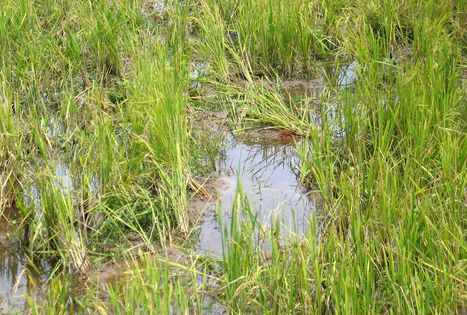
One other major problem caused by the elephants is the damaged of crops and properties (Figure 4.1). The poorer sections which are dependent on crops like paddy, ragi, jowar etc. have been largely affected by such incidents. The other important crops like coconut, cardamom, coffee and areca nut are also affected by elephant attacks and the loss in such crops is more severe as they are of high value and take lot of time and care to grow. According to the report a sum of Rs. 63.8 lakhs has been paid as compensation towards the crop damage during period 1986-2006. According to forest officials, from 2006-2009 a total of 4650 applications for compensation in crop damage cases have been filed.
According to the estimate of forest department these problems are caused by 23-24 elephants present in this area (Figure 4.2). Damages to fences, gates, irrigation pipelines, tree growth, etc. by the elephants has also been reported from these areas. The elephants have also caused injuries to domestic cattle and the compensation of amount Rs. 4.58 lakhs has been paid in this regard during 1986-2006. Such incidents have caused fear in hearts of people living in these areas and many of them are afraid to go for cultivation or work in estates as they fear for their lives.
Figure 4.2: Capturing wild elephant by KFD
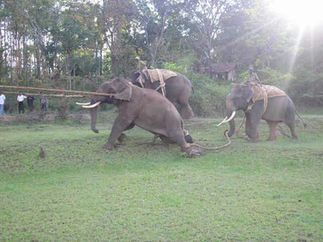
Table 4.1 shows the number of claims for compensation with respect to crop damage, human injuries and deaths (Figure 4.3) and cattle deaths filed by the affected people with the forest department during the year 1986-2006. The cases of elephant deaths have also reported from Hassan district in last few years. Table 4.2 provides the list of elephant deaths along with the reasons behind it. Figure 4.4 illustrates total number of claims and compensation amount paid during year 1986-2006. It can be clearly seen from the graph that there is a marked increase in the number of cases of HEC from 2002 to 2006. This indicates the importance of this issue and emphasizes the need to look into this matter with more concern.
Table 4.1 – Number of cases and compensation claims for damages, injuries and deaths in Human-Elephant Conflicts
| Year |
Crop Damage |
Injury to humans |
Human deaths |
Cattle killed/injured |
Total |
|
# Cases |
Amt.(lakhs) |
# Cases |
Amt.(lakhs) |
# Cases |
Amt.(lakhs) |
# Cases |
Amt.(lakhs) |
# Cases |
Amt.(lakhs) |
| 1986-87 |
112 |
0.511 |
11 |
0.078 |
1 |
0.05 |
28 |
0.142 |
162 |
0.782 |
| 1987-88 |
88 |
0.542 |
3 |
0.002 |
0 |
0 |
29 |
0.079 |
120 |
0.641 |
| 1988-89 |
93 |
0.378 |
1 |
0.002 |
1 |
0.1 |
16 |
0.168 |
111 |
0.668 |
| 1989-90 |
25 |
0.249 |
0 |
0 |
0 |
0 |
48 |
0.401 |
73 |
0.65 |
| 1990-91 |
81 |
0.445 |
1 |
0.05 |
1 |
0.1 |
17 |
0.109 |
99 |
0.66 |
| 1991-92 |
153 |
1.989 |
2 |
0.13 |
0 |
0 |
63 |
0.49 |
218 |
2.609 |
| 1992-93 |
89 |
1.09 |
6 |
0.615 |
0 |
0 |
24 |
0.118 |
119 |
1.742 |
| 1993-94 |
84 |
0.43 |
5 |
0.07 |
0 |
0 |
34 |
0.017 |
123 |
0.67 |
| 1994-95 |
48 |
0.629 |
13 |
0.271 |
0 |
0 |
35 |
0.02 |
96 |
1.101 |
| 1995-96 |
64 |
0.414 |
12 |
0.088 |
4 |
0.65 |
22 |
0.207 |
102 |
1.36 |
| 1996-97 |
167 |
1.232 |
20 |
0.194 |
5 |
1.05 |
39 |
0.346 |
231 |
2.823 |
| 1997-98 |
128 |
1.17 |
31 |
0.184 |
3 |
0.95 |
42 |
0.352 |
204 |
2.656 |
| 1998-99 |
215 |
1.779 |
25 |
0.313 |
2 |
0.75 |
66 |
0.553 |
308 |
3.396 |
| 1999-2000 |
149 |
1.037 |
15 |
0.271 |
1 |
1 |
29 |
0.258 |
194 |
2.566 |
| 2000-01 |
160 |
1.111 |
11 |
0.416 |
1 |
1 |
10 |
0.069 |
182 |
2.596 |
| 2001-02 |
92 |
0.558 |
1 |
0.02 |
3 |
2.3 |
0 |
0 |
96 |
2.878 |
| 2002-03 |
229 |
2.24 |
14 |
0.139 |
0 |
0 |
19 |
0.278 |
263 |
2.72 |
| 2003-04 |
372 |
4.454 |
14 |
0.413 |
2 |
3 |
13 |
0.186 |
401 |
7.053 |
| 2004-05 |
609 |
8.269 |
17 |
0.687 |
5 |
5 |
27 |
0.354 |
658 |
14.31 |
| 2005-06 |
1459 |
23.53 |
29 |
1.37 |
1 |
1 |
17 |
0.33 |
1506 |
26.24 |
| 2006-07 (Dec 06) |
1073 |
11.782 |
12 |
0.792 |
3 |
3 |
5 |
0.105 |
1093 |
15.68 |
| TOTAL |
5490 |
63.839 |
243 |
6.105 |
33 |
18.95 |
583 |
4.582 |
6359 |
93.799 |
| *Information provided by Conservator of forest, Hassan Circle |
Table 4.2: Details of the dead elephants past 5 years in Hassan division
| Sl No |
Year |
Place |
Date of death |
Gender |
Age |
Reason for death (Postmortem report) |
| 1 |
2004-05 |
Sakaleshpura |
03.12.2004 |
Male |
6 Yrs |
Due to Highly Purified organs, but suspected for generasled septiumia |
| 2 |
2005-06 |
- |
- |
- |
- |
- |
| 3 |
2006-07 |
Yasalluru |
20.03.2007 |
Female |
23-25yrs |
Electrocution |
| 4 |
2007-08 |
Aalluru |
04.09.2007 |
Female |
2 Yrs |
Sudden Pressure on the Diaphram and lung by any external hardmum |
| 5 |
2007-08 |
Aalluru |
16.11.2007 |
Male |
28 Yrs |
Sudden Pressure on diapharma and lungs by adbornianl organs due to sternal recumbany causes acute respiratory distress asphyxias shock & death |
| 6 |
2007-08 |
Aalluru |
03.12.2007 |
Female |
35 Yrs |
Sudden Pressure on diapharma and lungs by adbornianl organs due to stemal recumbany causes acute respiratory distress asphyxias shock and death |
| 7 |
2007-08 |
Sakaleshpura |
04.12.2007 |
Female |
7-8 Yrs |
Due to Highly Purified organs, but suspected for generasled septiumia |
| 8 |
2008-09 |
Yasalluru |
30.06.2008 |
Male |
30 Yrs |
Electrocution |
| 9 |
2008-09 |
Yasalluru |
03.08.2008 |
Single tusked |
25 Yrs |
Electrocution |
| 10 |
2008-09 |
Aalluru |
27.10.2008 |
Female |
18 Yrs |
Acute Bloat May be the cause for the death of animal |
| 11 |
2008-09 |
Aalluru |
30.11.2008 |
Male |
30 Yrs |
Electrocution |
| 12 |
2009-10 |
Yasalluru |
22.05.2009 |
Male |
25 Yrs |
Shock & Asphyxia |
| 13 |
2009-10 |
Aalluru |
03.10.2009 |
Male |
Yrs |
|
| 14 |
2009-10 |
Aalluru |
07.10.2009 |
Male |
Yrs |
|
Figure 4.3: Human death due to stray wild elephant

Figure 4.4: Compensation paid during 1986-2006
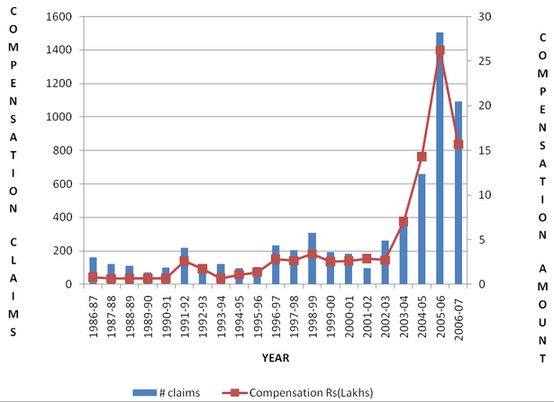
Human - Tiger Conflicts:
The Tiger is an endangered animal and is protected by various laws in India. Its presence has been found in areas of Kagneri, Kemphole, Edakumbri, Bisle RF and Pushpagiri WLS. The pug marks (Figure 4.5) have been recorded by the forest department and sightings of tiger has been reported by the local people. However, the number of tigers is not very large in this area. But, due to shrinkage and fragmentation of areas there have been incidents of tiger venturing into human settlements and causing trouble. There has been no record of human death caused by tiger in this region. In 2009-2010, four incidents were reported of attacks on cattle by the tiger (Figure 4.6). Six animals in nearby villages were killed in these incidents.
Figure 4.5: Pug mark of tiger indicating its presence in the forest
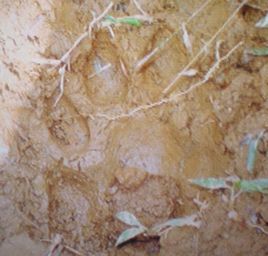
Figure 4.6: Cattle killed by a Tiger
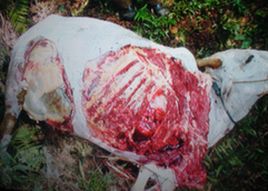
LIKELY IMPACTS OF GUNDIA HYDROELECTRIC PROJECTS ON HUMAN - ANIMAL CONFLICTS
The Gundia Hydroelectric Project (GHEP) proposal includes the construction of three weirs across Yettinaholle, Kerihole and Hongadahalla and dams across Bettakumbri and Hongadahalla. Due to these constructions the elephant habitats at Kerihole, Hongadahalla and Bisle reserve forest will be greatly affected. Large portions of surrounding areas will be submerged reducing habitats of elephants and causing fragmentation. The clearance of forest areas for mining excavation and laying down of tunnels with further contribute in habitat shrinkage. The construction of roads and other facilities will also require large scale clearance of forest areas. This will lead to deficiency in resources for the elephants and other animals living in the forest areas. Many people live in surrounding areas and practice agriculture and cash crops plantation. The habitat fragmentation due to this project will divert movements of elephants towards the human settlements leading to drastic increase in damage of crops, properties and human lives. In retaliation, the people will also harm the elephants, sometimes leading to its death, for their own protection thereby affecting population of already endangered animal. Due to increasing incidents of human-animal conflicts, it will also become a challenge for the forest department to develop conservation strategies for the existing population of elephants. The forest department will have to spend more time, energy and money in capturing and safe transferring of animals to a protected forest area away from human settlements.
FRAGMENTION OF CORRIDOR DUE TO GHEP:
Two important corridors have been observed for elephant movements passing through the Gundia and surrounding region. The first region Mudumalai in Tamil Nadu to Muttodi in Karnataka and passes through Nagarhole, Somwarpet, Brahmagiri, Pushpagiri, Bisle and Kemphole regions. The second corridor is from Nagarhole National Park upto Hemavathi Reservoir passing through Malambi, Bysur and Dodabetta. But due to construction of Hemavathy dam the second corridor has been fragmented with shrinkage of Dodabetta and Kattepura forest regions also. The local landscape has become unsuitable for elephants to properly survive and hence, the elephant take shelter in small forest patches during day and mostly at night venture out and raid crops in surrounding areas. This resulted in large number of human elephant conflicts in Hassan district.
Figure 4.7: Presence of foot prints and fresh dung highlight Elephant’s movement in the region (note on LHS, KPCL signage’s toppled by unhappy elephants at Mallalli)
If the GHEP proposal is implemented similar kind of fragmentation will be observed in the first corridor. The construction of Bettakumbri Dam will result in submergence of parts of Bisle Reserve forests as well as the construction of roads, tunnels and other facilities will create disruption in the entire area. Bisle Reserve forest is very rich in biodiversity and is an Eco-sensitive region. It is also one of important parts of the elephant corridor passing through this region. Thus, any kind of disturbance in this region will lead to fragmentation in this corridor and as a result the elephants will divert towards neighboring fields in search for resources ultimately leading to conflicts between humans and elephant.
Recommendations for Mitigating Human-Elephant Conflict
Important recommendations for mitigating Human Elephant Conflicts (Gajah, 2010) as suggested by The Elephant Task Force (ETF) set up by the Ministry of Environment and Forests (MoEF) that are applicable to this region are:
Given the seriousness of human-elephant conflict and its extreme gravity in certain areas, there should be a continuing programme for containing and defusing such conflict.
- All the elephant corridors listed in Right of Passage: Elephant Corridors of India publication and thereby agreed to by Project Elephant and state governments should be notified as state elephant corridors by respective State Governments and declared as ecologically sensitive areas.
- The corridors should be legally protected under various laws appropriate for the state and the local context, such as for e.g. a.) Community or Conservation Reserve, b.) Declaring the corridor as high priority Ecologically Sensitive Area under Environment Protection Act (EPA) with maximum regulation of ecologically destructive activity. c.) Declaring corridor land as Reserve Forest (RF) or Protected Forest (PF) under Indian Forest Act. d.) Community forests under the Forest Rights Act. e.) Increase boundary of existing Protected Area and make corridor part of the existing Protected Area (PA).
- Land use policies in elephant habitats especially corridors must be made clear to prevent further fragmentation of habitat or escalation of elephant-human conflict. The policies should be pragmatic enough to allow the corridors to be protected. It is very important for managers to enforce them strictly and with authority.
- Encroachment in corridors and elephant reserves have to be made punishable and fine imposed. Minimum fine of Rs 10 lakhs and imprisonment of not less than two years should be impose and has to be incorporated in Wildlife (Protection) Act, 1972 (WLPA). This is a major problem in most elephant areas.
- Constitution of conflict management task forces that will work in priority identified areas of high conflict. The Conflict Management Task Forces will begin work in sites identified by the Elephant Task Force. This scheme will be funded by the NECA and will be a permanent programme to mitigate and significantly reduce conflict on a continuing basis.
- Transparency of information is vital to build public confidence and also enable continuous re-evaluation of policies and programmes for mitigating and containing human elephant conflict. Transparency of information as on claims for loss of life, crops or property, loss of lives of people or elephants, numbers captured or killed be maintained.
- Culling elephants (killing of herds or whole groups of elephants as a technique of population management) be ruled out as a policy instrument as it is ethically unacceptable in the Indian context.
- Translocation of elephant populations are to be considered subject to strict conditions. It will work best if done for whole herds or family groups but whether in such cases or with individual bull’s viability of the approach should be carefully examined. Such translocated animals must be compulsorily monitored through the best means possible (such as telemetry) in order to ensure that they do not cause conflict elsewhere, and in order that the forest department can re-capture them in such eventuality.
- Capture of elephants from the wild as a conflict mitigation strategy may not be completely ruled out but this is not to be done on an ad hoc basis and is to be used with the greatest of care and under strict safeguards.
- Fences and Trenches can only work only as a part of a larger landscape level planned intervention (as outlined in the box sets out preliminary guidelines for their planning, application and participatory management).
- A moratorium on EPT is suggested and expensive electric fences without involving the community for maintenance to be discouraged. This could be reviewed by the Conflict Management Task Forces.
- Considering the persistent and common grievance in some areas that officials are not easily accessible to cultivators and other villagers affected by elephant and other wildlife crop damage, it is recommended that public hearings be held at least twice a year at taluk level. These must mandatorily require presence of not only the Wildlife Wing and Territorial Wing staff but also the revenue and civil authority and elected people’s representatives such as the MLA.
- The extent and severity of crop losses has led to deep resentment due to the burden on cultivators. Payments for the work of crop protection may be considered under the auspices of the MGNREGS. As in case of water harvesting on private lands, this will alleviate distress and reduce burden on cultivators.
- Loss of human life to elephants in conflict situations is deeply tragic and any immediate and medium term steps to reduce it are urgent and necessary. Ex gratia relief for loss of human life not to be less than 3 lakh rupees.
- There are serious policy hurdles due to the problems in recognizing wild animal damage as being subject to insurance cover. For the present, all crop loss amounts require re evaluation, and substantial upward revisions as per the state, region and crop. The PSU insurance companies should be approached by NECA/MOEF to take up and cover a few such sites on a pilot basis. Innovative schemes are already under way for mitigating losses. Schemes such as “Grain for Grain” require study and careful up-scaling and such attempts be encouraged and supported by government.
|